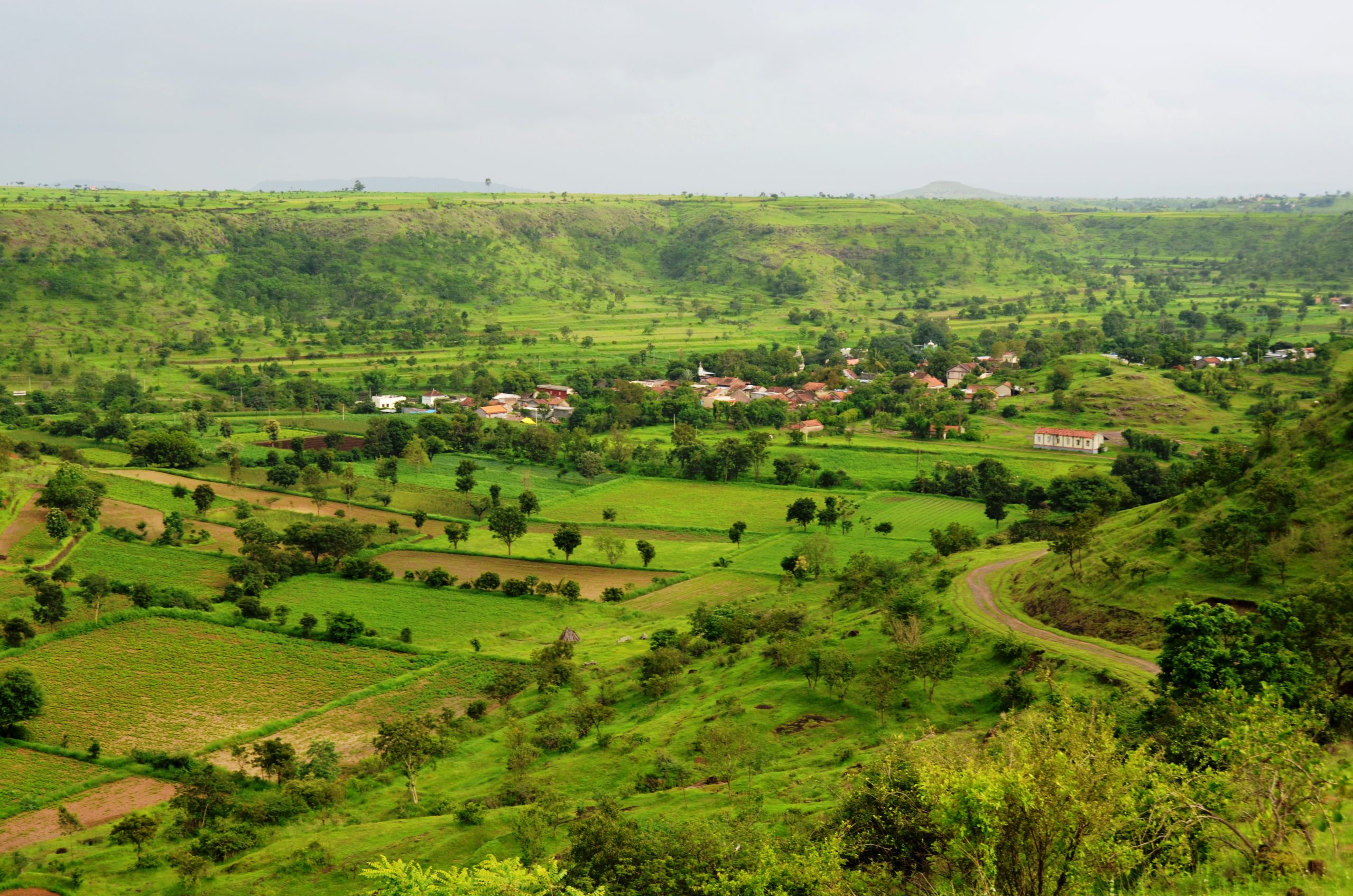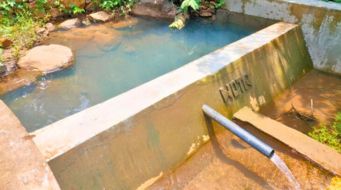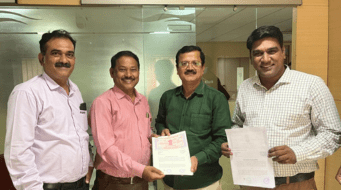A study of the effectiveness of nearly two decades of nature based and human centered interventions exemplifying the Ecosystem-based Adaptation (EbA) approach.
by Dada Dadas and Sonal Alvares
In sharing this case study, we hope to demonstrate the potential of EbA to create a much needed change-for-the-better in the lives of marginalised rural communities across India.
No options in an uncertain climate
Drought is the absence of water. A lack of precipitation precedes it. Soil loses moisture. Surface water trickles to a stop and ground water tables drop. Farmers dread droughts. Unable to grow crops, feed their families or their livestock, they are left with one option. Migration. They are forced to leave their village in search of water, food and a livelihood.

Life for the people of Bhojdari
Bhojdari is a village in the Sangamner block of Ahmednagar district in Maharashtra, India. Sangamner lies in the rain-shadow of the Western Ghats; it receives relatively less rainfall of around 550mm in a year. Unfortunately, Bhojdari is prone to drought. It consists of both an irrigated area and a plateau, locally referred to as Pathar. Home to a large section of socio-economically marginalised communities, Bhojdari faces several challenges. And unpredictable climatic events have only worsened the situation.

How it all began: first step to understand vulnerabilities and risks
WOTR conducted a community-driven vulnerability assessment in Bhojdari. The findings revealed a distressing trend of unseasonal and irregular rainfall since early 2000s as well as a delayed onset of and decrease in rainfall. Many families used to migrate, often forced to take up work under hazardous conditions to survive. Extreme climate events with increasing frequency destroyed standing crops, causing an irrecoverable loss of food and income and making life all the more difficult for the people of Bhojdari.
Change takes time; two decades of work on the ground
WOTR implemented three major projects in Bhojdari; the Indo-German Watershed Development Programme (IGWDP), 1996-2002, followed by the Climate Change Adaptation (CCA), 2009-2014 and the Water Stewardship Initiative (WSI), 2015-2017. Using a holistic design (Fig 1), a series of interventions were implemented to address the numerous challenges.

Study to assess effectiveness
WOTR, India and TMG Research, Germany conducted case-studies to understand whether and to what extent these interventions achieved the desired outcomes. These studies were a part of a project that seeks to understand the criteria and preconditions for Ecosystem-based Adaptation and upscale EbA through participatory, multi – stakeholder dialogues at local and state levels. The objective of the Bhojdari case-study was to assess the social, ecological and institutional effectiveness of the CCA and WSI projects. The framework used in the assessments builds on three elements: EbA should improve i) communities’ adaptive capacities, ii) ecosystems and biodiversity, and iii) participatory governance (Fig 2).

Learning about the impacts
Did the interventions help people adapt to climate change?
Through the study we looked for evidence of the difference made to livelihoods, incomes and investments, as also the wellbeing of the people, especially with food security, and whether there was a change in the migration patterns.
We found that incomes had increased by 37% due to the practice of climate-resilient agriculture, more focus on cash crops, and livestock rearing. The number of types of crops increased from 3 to 10. Farmers adopted the System of Crop Intensification (SCI)[i] and the use of indigenous seeds, thereby reducing costs and increasing resilience. Increased moisture and support irrigation helped them plant a second crop during winter. The increase in the number of dug- and bore-wells meant improved access to groundwater for irrigation. However, there is concern that indiscriminate extraction might cause problems in future.
We also found that overall there is an improvement in the quantity and duration of food available. Food shortages were halved. The people now consumed a more diverse diet including more vegetables such as spinach, soya bean, potatoes and cauliflower. Kitchen gardens offer dietary diversity at their doorstep and the earlier dependence on the forest for wild vegetables has diminished.
During droughts, many families used to migrate to neighbouring villages. We have found that distress migration has stopped ever since there has been an increase in available water and a second crop became quite common.
Was there an improvement in the ecosystem and biodiversity in the area?
We found that the forest cover and plantations increased by 43% due to farm forestry. With access to LPG through the government scheme, people did not need firewood, easing the pressure on forests.
Since 64% of the micro-watershed was treated through soil and water conservation measures, such interventions at the landscape level helped to halt soil erosion and encouraged cultivation on reclaimed gullies. Due to structures like percolation tanks, storage tanks etc. built by the Government’s Irrigation Department together with WOTR, the surface water storage capacity increased by 87%. Wells which used to dry up by December now have water till mid-May. Fodder crops, bore wells and dug wells increased due to renewed availability of groundwater. Unfortunately, the increase in ground water extraction through a larger number of wells has meant that the natural spring water stops flowing by the end of Rabi season and is something to be addressed in the future.

Photo credit: WOTR
Pushpa Vikas Hande, a young woman resident of Bhojdari and an active member of the Village Water Management team, said that her village has enough left over after using water for crops across two and at times even three seasons, for domestic use and for their animals. She says, thanks to water budgeting, their village no longer faces water scarcity like other villages in the state. Biodiversity in Bhojdari has improved following the interventions, given that the number of tree species increased in number to 32. Land-owners planted different kinds of trees on farm boundaries. This has helped meet fodder needs to a large extent. Populations of peacocks, deer, monkeys, jackals, foxes, leopards and some species of birds too have risen.
However, since wild boars destroy crops, the increase in their numbers has become a cause for concern. The number of indigenous or local breed livestock has reduced which meant that local vegetation is curtailed since seeds for regrowth was earlier dispersed through the local cows’ dung.
Was Participatory Governance strengthened?
More women in Bhojdari participated in governance and decision making during the implementation of the projects. Previously there was only one civil society institution involved in natural resource management, i.e. the watershed development committee. Four more institutions were formed including the Village Development Committee (VDC), Village Water Management Team (VWMT), Forest Protection Committee (FPC) and the Biodiversity Management Committee (BMC).
Democratic decision making, values like transparency in accounting as well as trust helped improved collective action among the people. The newer institutions improved the negotiating power with traditional institutions like the Forest Department and Irrigation Department. The BMC, for instance, provided information related to biodiversity and the People’s Biodiversity Register (PBR) documentation to the district and state Biodiversity Organisations/Board. It took responsibility for documentation, dissemination and conservation as well as maintenance, security and safety of the PBR. By design, the VDC, VWMT and FPC were created as sub-committees of the Gram Panchayat, to ensure collaboration with the latter. In the process, participation in common tasks such as Gram Sabha also improved as meetings were held more regularly.
Some of the committees have become dormant since the completion of the implementation of the projects, however several of them such as the VDC, VWMTs and several SHGs are still quite active.
Looking forward: EbA as an effective adaptation strategy for climate change

Today people of Bhojdari like Pushpa are able to build a more secure and predictable future for themselves and their families despite climate change and because of measures like EbA. Their story is no better indicator of the fact that when we nurture Nature we also nurture people.
Related articles:
Ecosystem-based Adaptation in Maharashtra, India: Voices from the ground. A film from Bhojdari: https://youtu.be/7RAtMslA4Qo
Rebuilding our food systems — an ecosystem-based approach for resilience. Blog link: https://medium.com/enabling-sustainability/rebuilding-our-food-systems-an-ecosystem-based-approach-for-resilience-a88ff5fe01b
Can an ecosystem-wide approach strengthen local resilience to climate change? Blog link: https://medium.com/enabling-sustainability/can-an-ecosystem-wide-approach-strengthen-local-resilience-to-climate-change-8c75b3663ba4
Adapting to climate change in India: International partnership explores an ecosystem-based approach in Maharashtra. Blog link: https://medium.com/enabling-sustainability/adapting-to-climate-variability-in-india-dd357ab750e4
[i] SCI is an agro-ecological method that creates enabling conditions for achieving plant potential through soil preparation and management, crop spacing, systematic application of locally prepared organic inputs and micro-nutrient foliar sprays.







1 thought on “An EbA Case Study – Nurturing Nature and People amid Climate Change in Bhojdari”
Awesome work. I hope that more such success stories will follow.